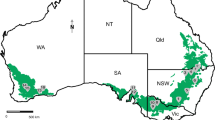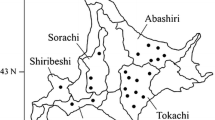Abstract
The oomycete Phytophthora colocasiae that causes taro leaf blight is the most devastating disease of taro and is widely distributed worldwide. Molecular and phenotypic techniques were employed for assessing and exploiting the genetic variability among four populations of P. colocasiae obtained from a fine spatial scale (multiple leaf blight lesions on single taro leaf). Phenotypic characters such as virulence, morphology and mating type showed no variation. ITS characterization revealed detectable polymorphism among isolates of P. colocasiae. The mean number of haplotypes (H), haplotype diversity (HD), nucleotide diversity (π), and nucleotide substitution rate (θ) among analyzed sequences were 6.75, 1.00, 0.069, and 0.088 respectively. High levels of inter and intra specific variation were detected by random amplified polymorphic DNA (RAPD) assays. Moderate genetic diversity (H = 0.2651) was observed among populations of P. colocasiae. Analysis of molecular variance (AMOVA) confirmed that most of the genetic variability was confined to within a population (63.54 %). The coefficient of genetic differentiation among populations (G ST ) was 0.2007 and estimates of gene flow (Nm) among populations was 1.991 migrants per generation. Cluster analysis using UPGMA revealed that individuals from the same population failed to cluster in one distinct group. The results of the study reveal considerable genetic diversity among and within populations of P. colocasiae obtained from fine spatial scale. The possible mechanisms and implications of this genetic variation are discussed.


Similar content being viewed by others
References
Abu-El Samen, F. M., Secor, G. A., & Gudmestad, N. C. (2003). Genetic variation among asexual progeny of Phytophthora infestans detected with RAPD and AFLP markers. Plant Pathology, 52, 314–325.
Agapow, P. M., & Burt, A. (2001). Indices of multilocus linkage disequilibrium. Molecular Ecology Notes, 1, 101–102.
Caetano-Anollés, G. (1993). Amplifying DNA with arbitrary oligonucleotide primers. Genome Research, 3, 85–94.
Cardenas, M., Grajales, A., Sierra, R., Rojas, A., Almario, A. G., Vargas, A., et al. (2011). Genetic diversity of Phytophthora infestans in the Northern Andean region. BMC Genetics, 12, 23.
Chang, T. T., Yang, W. W., & Wang, W. Y. (1996). Use of random amplified polymorphic DNA markers for the detection of genetic variation in Phytophthora cinnamomi in Taiwan. Botanical Bulletin of Academia Sinica, 37, 165–171.
Chamnanpunt, J., Shan, W. X., & Tyler, B. M. (2001). High frequency mitotic gene conversion in genetic hybrids of the Oomycete Phytophthora sojae. Proceedings of National Academy of Science USA, 98, 14530–14535.
Cooke, D. E. L., Kennedy, D. M., Guy, D. C., Russel, J., Unkles, S. E., & Duncan, J. M. (1996). Relatedness of groupI species of Phytophthora as assessed by randomly amplified polymorphic DNA (RAPD) and sequences of ribosomal DNA. Mycological Research, 100, 297–303.
Cooke, D. E. L., & Duncan, J. M. (1997). Phylogenetic analysis of Phytophthora species based on ITS1 and ITS2 sequences of the ribosomal RNA gene repeat. Mycological Research, 101, 667–677.
Drenth, A., Janssen, E. M., & Govers, F. (1995). Formation and survival of oospores of Phytophthora infestans under natural conditions. Plant Pathology, 44, 86–94.
Drenth, A., Whisson, S. C., Maclean, D. J., Irwin, J. A. G., Obst, N. R., & Ryley, M. J. (1996). The evolution of races of Phytophthora sojae in Australia. Phytopathology, 86, 163–169.
Excoffier, L., Smouse, P. E., & Quattro, J. M. (1992). Analysis of molecular variance inferred from metric distances among DNA haplotypes: application to human mitochondrial DNA restriction data. Genetics, 131, 479–491.
Fry, W. E., & Goodwin, S. B. (1995). Recent migrations of Phytophthora infestans. In L. J. Dowley, E. Bannon, L. R. Cooke, T. Keane, & E. O’Sullivan (Eds.), Phytophthora infestans 150 (pp. 89–95). Dublin: Boole Press.
Goodwin, S. B. (1997). The population genetics of Phytophthora. Phytopathology, 97, 462–473.
Jackson, G. V. H., Gollifer, D. E., & Newhook, F. J. (1980). Studies on the taro leaf blight fungus Phytophthora colocasiae in the Solomon Islands: control by fungicides and spacing. Annals of Applied Biology, 96, 1–10.
Koh, Y. J., Goodwin, S. B., Dyer, A. T., Cohen, B. A., Ogoshi, A., Sato, N., et al. (1994). Migrations and displacements of Phytophthora infestans in East Asian countries. Phytopathology, 84, 922–927.
Lakhanpaul, S., Velayudhan, K. C., & Bhat, K. V. (2003). Analysis of genetic diversity in Indian C. esculenta (Colocasia esculenta (L.)Schott) using random amplified polymorphicDNA (RAPD) markers. Genetic Resources and Crop Evolution, 50, 603–609.
Lebot, V., & Aradhya, K. M. (1991). Isozyme variation in taro (Colocasia esculenta (L.)Schott) from Asia and Oceania. Euphytica, 56, 55–66.
Lebot, V., Hartati, S., Hue, N. T., Viet, N. V., Nghia, N. H., & Okpul, T. (2000). Genetic variation in taro (Colocasia esculenta) in SouthEast Asia and Oceania. Twelfth Symposium of the ISTRC. Potential of root crops for food and industrial resources. Sept.10–16, 2000. Tsukuba, Japan, pp. 524–533.
Lebot, V., Herail, C., Gunua, T., Pardales, J., Prana, M., Thongjiem, M., et al. (2003). Isozyme and RAPD variation among Phytophthora colocasiae isolates from South East Asia and the Pacific. Plant Pathology, 52, 303–313.
Lewontin, R. C. (1972). The apportionment of human diversity. Evolutionary Biology, 6, 381–398.
Librado, P., & Rozas, J. (2009). Dnaspv5: A software for comprehensive analysis of DNA polymorphism data. Bioinformatics, 25, 1451–1452.
Lin, J. M., & Ko, H. W. (2008). Occurrence of isolates of Phytophthora colocasiae in Taiwan with homothallic behavior and its significance. Mycologia, 100(5), 727–734.
Lynch, M., & Milligan, B. G. (1994). Analysis of population genetic structure with RAPD markers. Molecular Ecology, 3, 91–99.
McDermott, J. M., & McDonald, B. A. (1993). Gene flow in plant pathosystems. Annual Review of Phytopathology, 31, 353–373.
Mahuku, G., Peters, R. D., Platt, H. W., & Daay, F. (2000). Random amplified polymorphic DNA analysis of Phytophthora infestans isolates collected in Canada during 1994–96. Plant Pathology, 49, 252–260.
Mantel, N. (1967). The detection of disease clustering and generalized regression approach. Cancer Research, 27, 209–220.
Manzanares-Dauleux, M. J., Divaret, I., Baron, F., & Thomas, G. (2001). Assessment of biological and molecular variability between and within field isolates of Plasmodiophora brassicae. Plant Pathology, 50, 165–173.
Meng, X. Q., Soemaker, R. C., & Yang, X. B. (1999). Analysis of pathogenicity and genetic variation among Phytophthora sojae isolates using RAPD. Mycological Research, 103, 173–179.
Mishra, A. K., Sharma, K., & Misra, R. S. (2010). Isozyme and PCR-based genotyping of epidemic Phytophthora colocasiae associated with taro leaf blight. Archives of Phytopathology and Plant Protection, 43(14), 1367–1380.
Misra, R. S., Sharma, K., & Mishra, A. K. (2008). Phytophthora leaf blight of Taro (Colocasia esculenta)—a review. The Asian and Australasian Journal of Plant Science and Biotechnology, 2, 55–63.
Misra, R. S., Mishra, A. K., Sharma, K., Jeeva, M. L., & Hegde, V. (2011). Characterisation of Phytophthora colocasiae isolates associated with leaf blight of taro in India. Archives of Phytopathology and Plant Protection, 44(6), 581–591.
Misra, R. S., & Chowdhury, S. R. (1997). Phytophthora leaf blight disease in taro. Technical Bulletin Series 21, C.T.C.R.I. (ICAR), Trivandrum.
Nath, V. S., Sankar, M. S., Hegde, V. M., Jeeva, M. L., Misra, R. S., Veena, S. S., et al. (2012). Analysis of genetic diversity in Phytophthora colocasiae using RAPD markers. The Asian and Australasian Journal of Plant Science and Biotechnology, 6(1), 38–43.
Nei, M., & Li, W. H. (1979). Mathematical modelfor studying genetic variation in terms of restriction endonucleases. Proceedings of National Academy of Science, USA, 76, 5269–5273.
Penner, G. A., Bush, A., Wise, R., Kim, W., Domier, L., Kasha, K., et al. (1993). Reproducibility of random amplified polymorphic DNA (RAPD) analysis among laboratories. Genome Research, 12, 341–345.
Raciborski, M. (1900). Parasitische Algen und Pilze, Java’s (Java’s Parasitic Algae and Fungi). I. Batavia. (Cited in Waterhouse1970a under P. colocasiae).
Rohlf, F. J. (1993). Contributions to morphometrics: Relative warp analysis and an example of its application to mosquito wings. In Marcus et al. (Eds.), Museo Nacional de Ciencias Naturales (pp. 131–159). Madrid
Saitou, N., & Nei, M. (1987). The neighbor-joining method: A new method for reconstructing phylogenetic trees. Molecular Biology and Evolution, 4, 406–425.
Schluter, P. M., & Harris, S. A. (2006). Analysis of multilocus fingerprinting data sets containing missing data. Molecular Ecology Notes, 6, 569–572.
Sharma, K., Mishra, A. K., & Misra, R. S. (2008). The genetic structure of C. esculenta: a comparison of RAPD and isozyme markers. Plant Biotechnology Reports, 2, 191–198.
Sullivan, M. J., Parks, E. J., Cubeta, M. A., Gallup, C. A., Melton, T. A., Moyer, J. W., et al. (2010). An assessment of the genetic diversity in a field population of Phytophthora nicotianae with a changing race structure. Plant Disease, 94(4), 455–460.
Tamura, K., Peterson, D., Peterson, N., Stecher, G., Nei, M., & Kumar, S. (2011). MEGA5: molecular evolutionary genetics analysis using maximum likelihood, evolutionary distance, and maximum parsimony methods. Molecular Biology and Evolution, 28(10), 2731–2739.
Thankappan, M. (1985). Leaf blight of taro-a review. Journal of Root Crops, 11, 223–236.
Thompson, J. D., Higgins, D. G., & Gibson, T. J. (1994). Clustal-W—Improving the sensitivity of progressive multiple sequence alignment through sequence weighting, position-specific gap penalties and weight matrix choice. Nucleic Acids Research, 22, 4673–4680.
Van de Peer, Y., & Dewachter, R. (1994). Treecon for Windows-A software package for the construction and drawing of evolutionary trees for the Microsoft Windows environment. Computer Applications in the Biosciences, 10, 569–570.
Wang, H. B., Wang, X. M., & Zhu, Z. D. (2003). Analysis of genetic diversity of Phytophthora sojae isolates in China using RAPD. Mycosystema, 22(2), 219–227.
White, T. J., Bruns, T., Lee, S., & Taylor, J. (1990). Amplification and direct sequencing of fungal ribosomal RNA genes for phylogenetics. In M. A. Innes, D. H. Gefland, J. Sninsky, & T. J. White (Eds.), PCR protocols: A guide to methods and applications (pp. 315–322). SanDiego: Academic.
Yeh, F. C., Boyle, T., Yang, R., Ye, Z., & Xiyan, J. M. (1997). Microsoft window-based freeware for population genetic analysis (POPGENE version 1.31). Edmonton: University of Alberta and Centre for International Forestry Research.
Acknowledgements
The funding provided for conducting the research work by the Indian Council of Agricultural Research, New Delhi, is gratefully acknowledged. The authors are grateful to Mr. U. Suresh Kumar, DNA examiner, DNA fingerprinting wing, Rajiv Gandhi Centre for Biotechnology, Thiruvananthapuram for his assistance in DNA sequencing and analysis. The authors express their deep gratitude to the anonymous reviewers for their valuable comments and helpful suggestions throughout the making of this manuscript.
Author information
Authors and Affiliations
Corresponding author
Rights and permissions
About this article
Cite this article
Nath, V.S., Senthil, M., Hegde, V.M. et al. Molecular evidence supports hypervariability in Phytophthora colocasiae associated with leaf blight of taro. Eur J Plant Pathol 136, 483–494 (2013). https://doi.org/10.1007/s10658-013-0181-z
Accepted:
Published:
Issue Date:
DOI: https://doi.org/10.1007/s10658-013-0181-z




